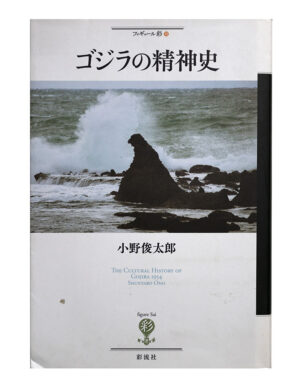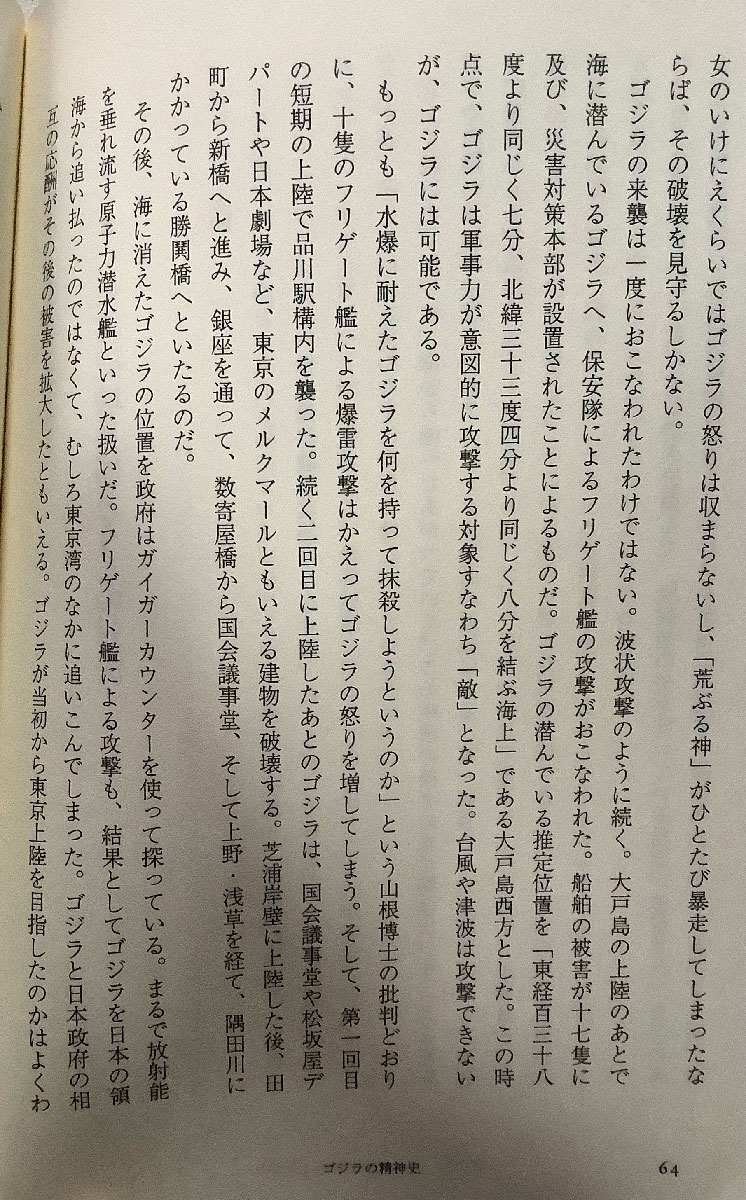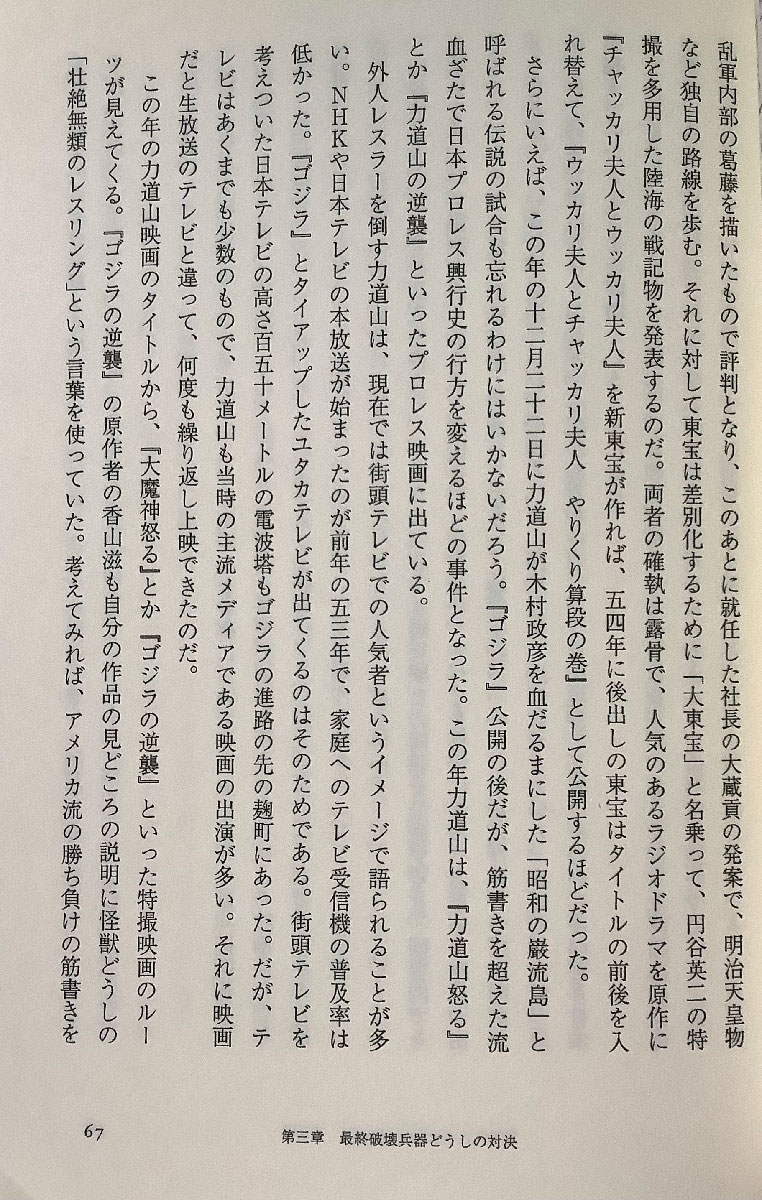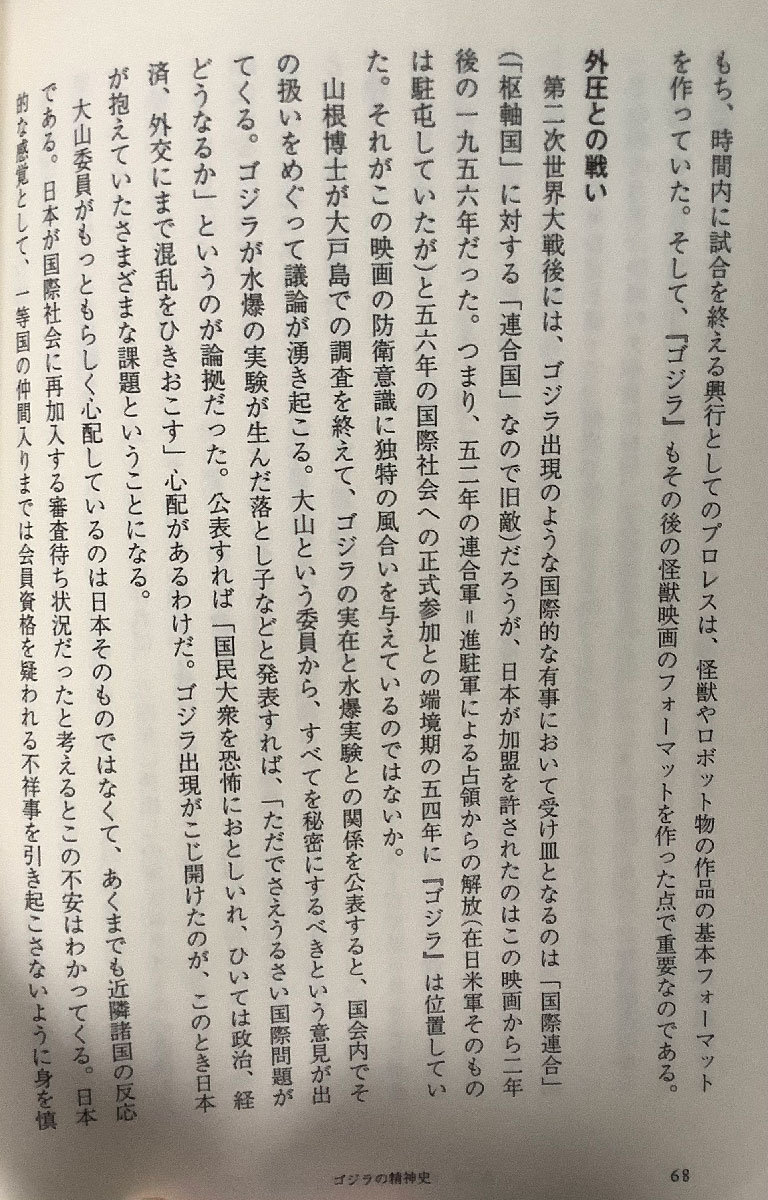1.30.2023
The Cultural History of Godzilla – Pt 27


P 65
ゴジラを囲む社会文脈
Social Context Surrounding Godzilla
『ゴジラ』といえば、すぐに三月一日のビキニ環礁の水爆実験との関係が話題になるが、それだけで生まれたわけではない。人々の記憶に残ったのには、この映画を支えた社会的文化的な背景が他にもあるはずだ。この年の日本映画のラインナップを眺めると、当時の日本の世相がすけて見えてくる。
Speaking of “Godzilla,” the topic immediately comes up with its connection to the Bikini Atoll hydrogen bomb test on March 1st, but that’s not all. There must have been other social and cultural backgrounds that supported this movie that made it memorable for people. If you look at the lineup of Japanese films from that year, you can see the social conditions in Japan at that time.
『風立ちぬ』や『伊豆の踊子』のような純文学に基づく文芸映画『君の名は』や『愛染かつら』のようなメロドラマ、さらにコメディアンのトニー谷を配した『家庭の事情 馬鹿じゃなかろうかの巻』のような喜劇が作られている。そんななかで、占領下で制作が制限されていた時代劇の仇討ものや戦記ものが公開されているのが目立つ。この年時代劇の東映は、単独の映画会社での製作本数世界一を記録する。チャンバラ場面が前面に出た『里見八犬伝』や『水戸黄門漫遊記』などの作品が伸び伸びと(?)発表できるようになったのも、GHQによる検閲がなくなったおかげである。
Literary films based on pure literature such as The Wind Rises and The Dancing Girl of Izu, as well as melodramas such as Your Name and Aizen Katsura; A comedy like “Katei no jijou: Bakka janakaro ka no maki” is being made. Under such circumstances, it is conspicuous that period dramas of revenge and war stories, whose production was restricted under the occupation, have been released. This year, the period drama Toei recorded the world’s largest number of films produced by a single film company. Works such as “Nanso Satomi Hakkenden” and “Mito Komon Manyuki,” which feature sword fighting scenes, can be released freely (?) thanks to the elimination of GHQ censorship.
The Wind Rises is about a lifelong love of flight inspires Japanese aviation engineer Jiro Horikoshi (Hideaki Anno), whose storied career includes the creation of the A6M World War II fighter plane.
The Dancing Girl of Izu The Dancing Girl of Izu or The Izu Dancer is a novel by Japanese writer and Nobel Prize winner Yasunari Kawabata first published in 1926. (Source: Wikipedia)
『家庭の事情 馬ッ鹿じゃなかろかの巻』”Family Circumstances Stupid Janakaroka no Maki” is a Japanese movie released on March 17, 1954 in a Toho series. (Source: Wikipedia)
Nanso Satomi Hakkenden is is a Japanese epic novel written and published over twenty-eight years in the Edo period, by Kyokutei Bakin. (Source: Wikipedia)
Mito Komon (水戸黄門) is a Japanese jidaigeki or period drama that was on prime-time television from 1969 to 2011, making it the longest-running jidaigeki in Japanese television history. (Source: Wikipedia)
Supreme Commander for the Allied Powers: In Japan, the position was generally referred to as GHQ (General Headquarters), as SCAP also referred to the offices of the occupation (which was officially referred by SCAP itself as General Headquarters, Supreme Commander for the Allied Powers (連合国軍最高司令官総司令部, Rengōkokugun saikōshireikan sōshireibu, abbreviated as GHQ–SCAP)), including a staff of several hundred US civil servants as well as military personnel. (Source: Wikipedia)

P 66
東宝では、黒澤明監督の『七人の侍』のように『ゴジラ』と関係が深い作品が一足先に完成して四月に公開されていた。個性派の浪人侍たちを統括する軍師役だった志村喬が、こちらでは古生物学者の山根博士となった。また、侍たちを雇う村の長老をやっていた高堂国典が、こちらでは大戸島に住ゴジラの存在を信じている老人になっていた。同じスクリーンで二つの映画を観た観客がつながりを感じたとしても不思議ではない。
At Toho, works closely related to “Godzilla,” such as Akira Kurosawa’s “Seven Samurai,” were completed ahead of schedule and released in April. Takashi Shimura, who played the role of the strategist who supervised the individualistic ronin samurai, became Dr. Yamane, a paleontologist here. Also, Kuninori Takado, who was an elder in the village that hires the samurai, is now an old man who believes in the existence of Godzilla, who lives on Odo Island. It’s not surprising that audiences who saw the two films on the same screen felt a connection.
マキノ正弘(正博)監督の『次郎長三国志』が第九部で七月に終了した。二代目広沢虎造の浪曲にうたわれた清水次郎長を描いた股旅映画の決定版となった映画だが、出演していた小泉博や若山セツ子は『ゴジラの逆襲』に登場する。さらに、本多猪四郎は、特撮を多用した東宝戦記物路線の出発点となる山本五十六を扱った『太平洋の鷲』を前年に監督したのに続いて、酒場で流行していた「ラバウル小唄」に基づく『さらばラバウル最後の戦闘機』という戦記物を二月に完成させていた。そのあとで『ゴジラ』に向かったのだ。
Jirocho Sangokushi, directed by Masahiro Makino, ended in July with the ninth part. This is the definitive version of the movie about the journey of Jiro Shimizu, who was sung in the rokyoku by Torazo Hirosawa II. Hiroshi Koizumi and Setsuko Wakayama, who had appeared, will appear in “Godzilla Raids Again.” In addition, Ishiro Honda directed “Operation Kamikaze,” which dealt with Isoroku Yamamoto, which was the starting point of the Toho war story line that used a lot of special effects, the previous year. In February, he completed a war memoir called Farewell to Rabaul’s Last Fighter based on Rabaul Kouta. After that, he went to “Godzilla.”
東宝がこうした戦記物路線をとったのには、東宝争議で別れてできた新東宝が、『戦艦大和』や『潜水艦ろ号未だ浮上せず』といった戦記物を発表していることへの対抗意識があった。新東宝は「二・二六事件」を扱った立野信之の直木賞小説『叛乱』の映画化を佐分利信の監督でおこなった。叛乱軍内部の葛藤を描いたもので評判となり、このあとに就任した社長の大蔵貢の発案で、明治天皇物など独自の路線を歩む。それに対して東宝は差別化するために「大東宝」と名乗って、円谷英二の特撮を多用した陸海の戦記物を発表するのだ。両者の確執は露骨で、人気のあるラジオドラマを原作に『チャッカリ夫人とウッカリ夫人』を新東宝が作れば、五四年に後出しの東宝はタイトルの前後を入れ替えて、『ウッカリ夫人とチャッカリ夫人やりくり算段の巻』として公開するほどだった。
The reason why Toho took such a war chronicle route was to counter the fact that Shin Toho, which was formed after breaking up due to the Toho dispute, had released war chronicles such as “Battleship Yamato” and “Sensuikan Rogo imada fujosezu.” Shintoho directed Nobu Saburi’s film adaptation of Nobuyuki Tateno’s Naoki Prize-winning novel Hanran, which dealt with the February 26 incident. It became popular for depicting the internal conflicts of the rebellion army, and at the suggestion of Mitsugu Okura, the company president who took office after this, he took his own course, such as the Emperor Meiji. On the other hand, Toho called itself “DaiToho” in order to differentiate itself, and announces war stories about land and sea that make extensive use of Eiji Tsuburaya’s special effects. The feud between the two was blatant, and if Shintoho made “Chakkari fujin to Ukkari fujin” based on the popular radio drama, Toho would switch the front and back of the title in 1954 to produce “Chakkari fujin to Ukkari fujin.”
“Jirocho Sangokushi” is the title of the period novel written by Genzo Murakami, in which Jirocho Shimizu is the main character, and the movie series directed by Masahiro Makino based on the same work. “Three countries” in this work refers to Suruga Province (currently central Shizuoka Prefecture), Totomi Province (currently western Shizuoka Prefecture), and Mikawa Province (currently eastern Aichi Prefecture).(Source: Wikipedia)
Eagle of the Pacific, also known as Operation Kamikaze, is a 1953 Japanese epic war film directed by Ishirō Honda. The film dramatizes the start of Japan’s military action in World War II, with an emphasis on the role of Isoroku Yamamoto. (Source: Wikipedia)
The February 26 Incident was an attempted coup d’état in the Empire of Japan on 26 February 1936. It was organized by a group of young Imperial Japanese Army officers with the goal of purging the government and military leadership of their factional rivals and ideological opponents. (Source: Wikipedia)
“Chakkari fujin to Ukkari fujin” is a Japanese film released in 1952 (Showa 27) and released on April 24, 1952. Produced and distributed by Shintoho. The radio drama “Chagari and Ugari” became “Chagari and Toukari.” At the time of the production of this work, Mrs. Chakkari on the radio was Mie Minami, and Mrs. Ukkari was Fumie Kitahara. (Source: Wikipedia)

P 67
さらにいえば、この年の十二月二十二日に力道山が木村政彦を血だるまにした「昭和の巌流島」と呼ばれる伝説の試合も忘れるわけにはいかないだろう。『ゴジラ』公開の後だが、筋書きを超えた流血ざたで日本プロレス興行史の行方を変えるほどの事件となった。この年力道山は、『力道山怒る』とか『力道山の逆襲』といったプロレス映画に出ている。
In addition, we cannot forget the legendary match called “Ganryujima of Showa” where Rikidozan left Masahiko Kimura in blood on December 22nd of this year. Although it was after the release of “Godzilla,” it became an incident that changed the direction of the history of Japanese professional wrestling with bloodshed beyond the plot. This year Rikidozan appeared in professional wrestling movies such as “Rikidozan’s Angry” and “Rikidozan’s Revenge.”

P68
この年の力道山映画のタイトルから、『大魔神怒る』とか『ゴジラの逆襲』といった特撮映画のルーツが見えてくる。『ゴジラの逆襲』の原作者の香山滋も自分の作品の見どころの説明に怪獣どうしの「壮絶無類のレスリング」という言葉を使っていた。考えてみれば、アメリカ流の勝ち負けの筋書きをもち、時間内に試合を終える興行としてのプロレスは、怪獣やロボット物の作品の基本フォーマットを作っていた。そして、「ゴジラ」もその後の怪獣映画のフォーマットを作った点で重要なのである。
From the title of the Rikidozan movie of that year, we can see the roots of special effects movies such as “Daimajin” and “Godzilla Raids Again.” Shigeru Kayama, the author of “Godzilla Raids Again,” also used the phrase “unparalleled wrestling” between monsters to explain the highlights of his work. Come to think of it, professional wrestling as a show that has an American-style win-or-lose scenario and finishes the match within the allotted time has created the basic format for works of monsters and robots. And “Godzilla” is also important in that it created the format for subsequent monster movies.